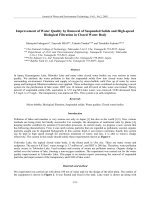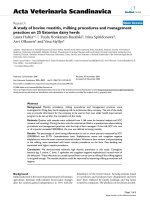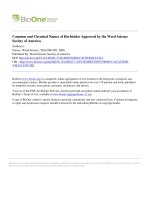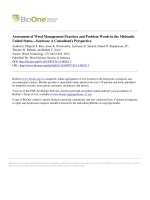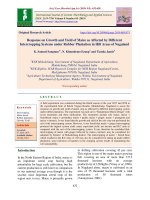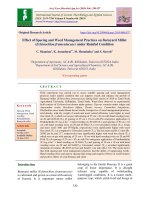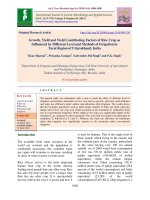Yield improvement of Kharif rice by different weed management practices
Bạn đang xem bản rút gọn của tài liệu. Xem và tải ngay bản đầy đủ của tài liệu tại đây (188.86 KB, 7 trang )
Int.J.Curr.Microbiol.App.Sci (2019) 8(3): 346-352
International Journal of Current Microbiology and Applied Sciences
ISSN: 2319-7706 Volume 8 Number 03 (2019)
Journal homepage:
Original Research Article
/>
Yield Improvement of Kharif Rice by Different
Weed Management Practices
Nirmala Patel* and Pritam Ghosh
Department of Agronomy, Palli Siksha Bhavana, Visva-Bharati, West Bengal, India
*Corresponding author
ABSTRACT
Keywords
Pyrazosulfuron
ethyl, Hand
weeding, Weed
management, Rice
Article Info
Accepted:
04 February 2019
Available Online:
10 March 2019
A field experiment was conducted during kharif 2017 at the Agricultural Farm, Palli
Siksha Bhavana, Visva-Bharati, Sriniketan, Birbhum, West Bengal to study the effect of
different weed management practices on yield improvement of transplanted kharif rice.
Nine treatments viz; pretilachlor 500 g/ha as pre emergence, oxadiargyl 90 g/ha as pre
emergence, pyrazosulfuron ethyl 25 g/ha as pre emergence, pretilachlor 500 g/ha as PE
followed by hand weeding at 40 DAT, oxadiargyl 90 g/ha as PE followed by hand
weeding at 40 DAT, pyrazosulfuron ethyl 25 g/ha as PE followed by hand weeding at 40
DAT, hand weeding twice at 20 and 40 DAT, weed free and unweeded control were tested
in randomized complete block design with three replications. The predominant weed flora
present in the experimental field was Echinochloa glabrescens, Cyperus difformis,
Cyperus iria and Ludwigia parviflora. All weed control treatments significantly reduced
the population and dry weight of all categories of weeds viz., grasses, sedges and broadleaf
weeds than unweeded control which resulted significant increase in different growth
parameters of transplanted kharif rice. Among the herbicide applied treatments,
pyrazosulfuron ethyl 25g/ha fb one hand weeding at 40 DAT resulted in significantly
higher values of plant height, leaf area index, dry matter accumulation, crop growth rate
and ultimately grain yield (5.22 t/ha) of rice than that of unweeded control. Hand weeding
at 20 and 40 DAT was statistically at par with pyrazosulfuron ethyl 25g/ha fb one hand
weeding at 40 DAT.
production of 106.29 million tonnes and
productivity of 2462 kg ha-1.
Introduction
Rice is the world’s most important staple food
crop for more than half of the world’s
population, occupying a prime place after
wheat and is the main source of carbohydrate,
protein and calories for a large section of the
population. Globally, rice occupies an area of
147 million hectares with production of 525
million tonnes. In India, it is produced in an
area of 46.19 million hectares with a
Rice is cultivated in a very wide range of
ecosystems from irrigated to shallow
lowlands, mid-deep lowlands and deep water
to uplands. Transplanting in puddled soil with
continuous flooding is the major method of
rice cultivation in India. Weed infestation is
one of the serious constraints in rice
production. Weed affects rice by competing
346
Int.J.Curr.Microbiol.App.Sci (2019) 8(3): 346-352
ha-1). Rice seeds were sown first in nursery
and after 21 days they were uprooted and
transplanted in the main field at the rate of 7
kg ha-1 by following 20 cm x 15 cm spacing
on 16th July 2017. The rice variety used was
MTU-1010.
for nutrient, light, water and space accounting
nearly one third of crop loss. Transplanted
rice crop faces diverse type of weed flora,
consisting of grasses, sedges and some broadleaf weeds, which reduces yield up to 48 per
cent with an annual loss of 15 million tonnes
due to weed competition. Prevention of weed
competition and provision of weed free
environment at critical period of rice growth
is necessary for successful rice production
(Murali and Gowthami, 2017). Most
transplanted
rice
growers
in
India
mechanically weed their crops two or three
times per season (Rodder, 2001) raising cost
of labour and their non-availability in time
lead to the search for alternative methods.
Herbicides offer the most effective,
economical and practical way of weed
management (Sureshkumar and Durairaj,
2016). So, there is a need to evaluate the
effect of new herbicides on growth of
transplanted rice for providing wider options
to farmers.
The Treatments consisted of T1=Pretilachlor
500 g/ha as pre emergence, T2=Oxadiargyl 90
g/ha as pre emergence, T3=Pyrazosulfuron
ethyl 25 g/ha as pre emergence,
T4=Pretilachlor 500 g/ha as PE followed by
hand weeding at 40 DAT, T5=Oxadiargyl 90
g/ha as PE followed by hand weeding at 40
DAT, T6= Pyrazosulfuron ethyl 25 g/ha as PE
followed by hand weeding at 40 DAT, T7=
Hand weeding twice at 20 DAT and 40 DAT,
T8=Weed free, T9=Unweeded control. The pre
emergence herbicides were applied at 3 DAT
as sand mix application through knap sack
sprayer using a spray volume of 500 L ha-1.
Weed density and weed dry weight were
recorded at 20, 40, 60 DAT. At each sampling
time, two quadrates of 50 cm×50 cm were
placed randomly in each plot and weeds were
collected from each quadrate and converted to
numbers per m2. Weeds were uprooted,
washed with tap water, sundried, oven-dried
at 65 °C for 48 hours. After attaining the
constant weight, the samples were weighed
and the weed dry weight was expressed in
grams per m2. The square-root transformation
of original data of weeds was done for
statistical analysis as described by Cochran
and Cox (1957).
Materials and Methods
A field experiment, “Weed management in
transplanted kharif rice (Oryza sativa L.)'' was
conducted in Block-A, Plot no- 2 of the
Agricultural Farm of Palli Siksha Bhavana,
Visva-Bharati, Sriniketan during kharif
season of 2017 to study the effect of different
weed management practices on growth of
transplanted kharif rice. The experiment was
laid out in RBD design with nine treatments
and three replications. The net plot size was 5
m x 4 m. The fertilizers were applied
considering 80:40:40 kg of N: P2O5: K2O per
ha as recommended dose as urea, single
superphosphate and murate of potash,
respectively.
The growth parameters like plant height, leaf
area index (LAI), dry matter accumulation
and Crop Growth Rate (CGR) were recorded
at 20, 40, 60 DAT. Yield data recorded after
the harvest of rice crop. Collected data were
analyzed statistically and the means were
separated by least significant difference
(LSD) test.
The experimental site was sandy loam with
acidic pH (5.36), EC (0.61 dSm-1), medium in
organic carbon (0.57 %), available N (385 kg
ha-1), P2O5 (23.4 kg ha-1) and K2O (191 kg
347
Int.J.Curr.Microbiol.App.Sci (2019) 8(3): 346-352
emergence fb hand weeding at 40 DAT
recorded highest plant height. Pyrazosulfuron
ethyl controls the weeds more efficiently than
Oxadiargyl and Pretilachlor as the result the
growth resources were more available to the
plants in Pyrazosulfuron ethyl treated plots
(Banerjee et al., 2005).
Results and Discussion
Effect of weed management on dry weight
of weeds
The data presented in Table 1 on dry weight
of weeds revealed that all the weed control
treatments reduced the weed dry weight
significantly from that of unweeded
treatment. The weed free treatment registered
the lowest dry weight of weeds (0.71 g/m2).
Among the weed control treatments, the
lowest weed dry weight were registered in
Pyrazosulfuron ethyl 25g/ha as preemergence fb hand weeding at 40 DAT at 20
DAT and 60 DAT. It was closely followed by
Hand weeding at 20 and 40 DAT. All other
weed control treatments did not differ
significantly from Pyrazosulfuron ethyl
25g/ha as pre-emergence fb hand weeding at
40 DAT at 20 DAT and 60 DAT. The highest
weed dry weight recorded with unweeded
check for all the stages (4.89, 13.74, 16.52
g/m2).
Effect of weed management on LAI
In all the observations (Table 2) the highest
LAI was observed in weed free treatment
which may be due to lowest crop-weed
competition in that plot. The lowest LAI was
found in unweeded control plots. There weed
free plot varied significantly from that of the
control plot. Leaf Area Index was found in the
trend of weedfree > hand weeding at 20 and
40 DAT > Pyrazosulfuron ethyl 25g/ha as
pre-emergence fb hand weeding at 40 DAT in
15 and 30 DAT and weedfree >
Pyrazosulfuron ethyl 25g/ha as preemergence fb hand weeding at 40 DAT >
hand weeding at 20 and 40 DAT, found at 45
DAT. Pyrazosulfuron ethyl treated plot (T3
and T6) recorded higher LAI. This might be
due to its better efficacy against Oxadiargyl
and Pretilachlor. Pal et al., (2012) got similar
findings.
Effect of weed management on plant height
Data recorded on plant height at different
growth stages (15, 30 and 45 DAT) were
statistically analysed and presented in Table
2. From all the observations it was found that
at 15 and 30 DAT, weed free plots recorded
highest plant height due to no crop weed
competition throughout the crop growth
period. Repeated weeding led to better
aeration and non occurrence of toxic gases
which improve the crop growth. The lowest
plant height was observed under unweeded
control plots. In unweeded control, the weeds
were allowed to grow uninterruptedly
throughout the crop growth period. It resulted
in maximum crop weed competition for
growth resources since beginning resulting
minimum height of rice plants. Among
different chemical weed control treatments
Pyrazosulfuron ethyl 25g/ha as pre-
Effect of weed management on dry matter
accumulation g/m2
Data presented in Table 2 showed that the
highest dry matter was found in weed free
plot in all three crop growth stages. Among
the chemically treated plots, Pyrazosulfuron
ethyl 25g/ha as pre-emergence fb hand
weeding at 40 DAT shown better dry matter
accumulation. The lowest plant dry matter
was observed in case of unweeded control
plot, as no weed control practices was
practiced there; it led to minimum plant dry
matter accumulation. In case of weed free
plot, maximum dry matter was recorded
which might be due to continuous weed
348
Int.J.Curr.Microbiol.App.Sci (2019) 8(3): 346-352
control was followed since beginning. So no
weed competition was there and better plant
growth was observed. Also better aeration
might be lead to maximum dry matter
production. Pyrazosulfuron ethyl treated plots
(T3 and T6) recorded higher dry matter among
the chemically controlled plots, which might
be due to lower weed competition and dry
weight of weeds that lead to more nutrient
availability to plants and higher growth
parameter and ultimately higher dry matter
accumulation as compared to Oxadiargyl (T2
and T5) and Pretilachlor (T1 and T4).
lowest in unweeded control plot. In case of
weed free plot highest CGR was recorded
which was might be due to no crop weed
competition. In case of unweeded control
more crop weed competition was there so
minimum crop growth rate was observed. At
30-45 DAT CGR value varied from a
minimum of 12.96 g/m2/day in Pretilachlor
500g/ha as pre-emergence to 19.39 g/m2/day
in Oxadiargyl 90g/ha as pre-emergence fb
hand weeding at 40 DAT.
Effect of weed management on grain yield
of rice
Effect of weed management on crop
growth rate
The yield data presented in Table 3 depicted
that weed control treatments significantly
affect the grain yield of transplanted kharif
rice. Unweeded control plot produced lowest
grain yield (3.33 t/ha) which was significantly
lower than all weed control treatments.
The CGR value (Table 3) at 15-30 DAT
varied from 10.85 g/m2/day to a maximum of
14.31 g/m2/day. The highest CGR value at 15
- 30 DAT recorded in weed free treatment and
Table.1 Effect of weed management on dry weight of weeds (g/m2)
Treatments
T1 (Pretilachlor 500g/ha as pre-emergence)
T2 (Oxadiargyl 90g/ha as pre-emergence)
T3(Pyrazosulfuron ethyl 25g/ha as preemergence)
T4 (Pretilachlor 500g/ha as pre-emergence fb
hand weeding at 40 DAT)
T5 (Oxadiargyl 90g/ha as pre-emergence fb hand
weeding at 40 DAT))
T6 (Pyrazosulfuron ethyl 25g/ha as preemergence fb hand weeding at 40 DAT)
T7(Hand weeding at 20 & 40 DAT)
T8(Weed free)
T9 (Unweeded control)
S.Em (±)
CD at 5 %
CV(%)
349
Dry weight of total weeds (g/m2)
20DAT
40DAT
60 DAT
1.48
1.81
2.10
(1.71)
(2.76)
(3.90)
1.23
1.63
1.98
(1.01)
(2.18)
(3.41)
1.08
1.47
1.88
(0.67)
(1.65)
(3.02)
1.35
1.80
1.51
(1.33)
(2.74)
(1.79)
1.15
1.64
1.48
(70.83)
(2.21)
(1.68)
1.07
1.27
1.29
(0.64)
(1.10)
(1.15)
1.07
1.19
1.32
(0.65)
(0.91)
(1.25)
0.71
0.71
0.71
(0.00)
(0.00)
(0.00)
2.32
3.77
4.12
(4.89)
(13.74)
(16.52)
0.04
0.03
0.03
0.12
0.09
0.09
5.43
2.98
2.74
Int.J.Curr.Microbiol.App.Sci (2019) 8(3): 346-352
Table.2 Effect of weed management on Plant height (cm), Leaf Area Index (LAI) and Plant dry matter accumulation (g/m2)
Plant height (cm)
LAI
Dry matter accumulation
(g/m2)
Treatments
15DAT
30DAT
45DAT
15DAT
30DAT
45 DAT
T1(Pretilachlor 500g/ha as preemergence)
41.17
70.38
90.83
1.92
3.10
3.45
39.89
215.38
413.17
T2(Oxadiargyl 90g/ha as preemergence)
42.19
70.69
91.81
2.18
3.17
3.51
41.32
223.22
417.67
T3(Pyrazosulfuron ethyl 25g/ha as
pre-emergence)
42.24
71.09
93.01
2.39
3.30
3.60
43.44
236.64
486.33
T4 (Pretilachlor 500g/ha as preemergence fb hand weeding at 40
DAT)
41.21
70.09
94.13
1.86
3.04
3.92
39.86
219.76
508.00
T5(Oxadiargyl 90g/ha as preemergence fb hand weeding at 40
DAT))
42.13
70.78
94.24
2.29
3.44
4.01
43.22
220.36
511.22
T6(Pyrazosulfuron ethyl 25g/ha as
pre-emergence fb hand weeding at
40 DAT)
42.50
71.47
95.33
2.38
3.50
4.18
52.89
248.89
513.44
T7(Hand weeding at 20 &40 DAT)
42.71
72.06
91.69
2.50
3.68
4.17
42.00
247.67
486.56
T8(Weed free)
45.90
75.07
94.46
2.77
3.75
4.23
62.78
277.47
550.61
T9 (Unweeded control)
39.90
68.27
90.81
1.79
2.90
3.36
41.67
204.45
404.39
S.Em (±)
0.85
0.64
0.98
0.18
0.09
3.98
3.71
20.32
CD at 5 %
2.55
1.91
2.94
0.53
0.27
0.37
11.93
11.13
60.90
CV (%)
3.49
1.55
1.83
13.72
4.68
5.59
15.23
2.76
7.38
350
0.12
15DAT
30DAT
45DAT
Int.J.Curr.Microbiol.App.Sci (2019) 8(3): 346-352
Table.3 Effect of weed management on Crop Growth Rate (g/m2/day)
Treatments
T1(Pretilachlor 500g/ha as pre-emergence)
T2(Oxadiargyl 90g/ha as pre-emergence)
T3(Pyrazosulfuron ethyl 25g/ha as preemergence)
T4 (Pretilachlor 500g/ha as pre-emergence
fb hand weeding at 40 DAT)
T5(Oxadiargyl 90g/ha as pre-emergence fb
hand weeding at 40 DAT))
T6(Pyrazosulfuron ethyl 25g/ha as preemergence fb hand weeding at 40 DAT)
T7(Hand weeding at 20 &40 DAT)
T8(Weed free)
T9 (Unweeded control)
S.Em (±)
CD at 5 %
CV(%)
CGR (g/m2/day)
15-30 DAT
30-45DAT
11.70
13.19
12.13
12.96
12.88
16.65
Grain yield was recorded highest of 5.41 t/ha
(62.46% increase over control) in weed free
treatment, due to lowest crop-weed
competition. Pyrazosulfuron ethyl 25g/ha as
pre-emergence fb hand weeding at 40 DAT
and Hand weeding at 20 and 40 DAT
produced 5.22 t/ha and 5.12 t/ha grain yield
respectively which were at par with the weed
free treatment. It was also observed that hand
weeding at 40 DAT increased the grain yield
over sole application of chemical weed
control methods.
Grain yield
(t/ha)
3.93
4.01
4.12
11.99
19.22
4.56
11.81
19.39
4.90
13.07
17.64
5.22
13.71
14.31
10.85
0.37
1.12
5.17
15.93
18.21
13.33
1.34
4.02
14.25
5.12
5.41
3.33
0.13
0.39
5.02
References
Banerjee, P., Dutta, D., Biswas, S.,
Bandyopadhyay, P. and Maiti, D.
2005. Effect of irrigation and weed
management on weed growth and
yield performance of transplanted
hybrid rice. Journal of Crop and Weed
1 (2): 20-22.
Cochran, W. G. and Cox, G. M., 1957,
Experimental design. 2nd Edition,
John Willey and Sons, Inc. New York,
p. 615.
Maheswari, M. D., A. S. Rao, P. Prasuna Rani
and B. Venkateswarlu. 2015. Effect of
Weed Management 5Practices on
Growth
and
Economics
of
Transplanted
Rice.
International
Journal of Pure and Applied
Bioscience, 3(3): 113-116.
Murali, A. P. and S. Gowthami. 2017. Early
Post Emergence Herbicide and Their
Influence on Weed Population
Dynamics in Transplanted Rice
In conclusion, weeds are a major constraint in
transplanted kharif rice. The present study has
revealed that different weed management
practices affect the plant growth parameters
significantly. Although hand weeding was the
most favorable mean of plant growth
Pyrazosulfuron ethyl 25g/ha as preemergence fb hand weeding at 40 DAT was
found good among different combined means
of weed management practices.
351
Int.J.Curr.Microbiol.App.Sci (2019) 8(3): 346-352
(Oryza Sativa L.). Chemical Science
and Review Letter, 6(21): 561-566.
Pal, S., Ghosh, R.K., Banerjee, H., Kundu, R.
and Alipatra, A. 2012. Effect of
pyrazosulfuron-ethyl on yield of
transplanted rice. Indian Journal of
Weed Science 44(4): 210–213.
Rodder W. 2001. Slash and burn rice systems
in the hills of Northern Lao PDR. In.
Description,
challenges
and
opportunities IRRI, LOS Banos,
Philippines, 201 pp.
Singh, YG, Singh V.P., Singh, P.,
Shrivastava, R.S.I., Saxena, A.,
Mortimer, M., Johnson, D.E., and
White J.L. 2002. Effect of different
establishment methods on rice-wheat
and the implication of weed
management in Indo-Gangetic Plains.
In. proceedings of the International
workshop on Herbicide Resistance
management and zero tillage in Ricewheat cropping system, 4-6 March
2002. Department of Agronomy, CCS
Hryana Agricultural University, Hisar,
India, pp.188-192.
Sureshkumar, R. and Durairaj. 2016. Weed
characters and indices of transplanted
rice as influenced by different weed
management practices. International
Journal of Agriculture Sciences.
8(51): 2221-2223.
How to cite this article:
Nirmala Patel and Pritam Ghosh. 2019. Yield Improvement of Kharif Rice by Different Weed
Management Practices. Int.J.Curr.Microbiol.App.Sci. 8(03): 346-352.
doi: />
352
